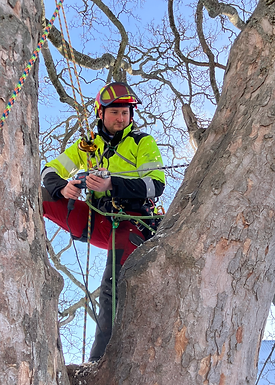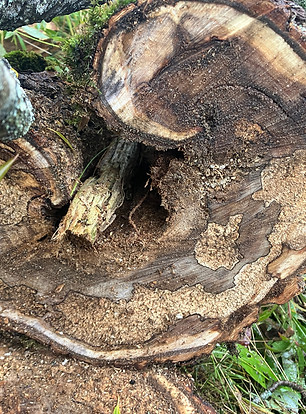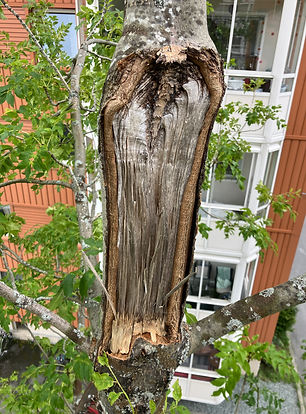





OLD LINDEN TREE WAISENHUSET
Between Prinsens gate and Waisenhuset in Trondheim, there is a strange old linden tree.
The trunk is completely hollow and stunted, and has obviously stood here for a long time.
This linden tree was formerly part of Bispehaven, the bishop's residence, and before that probably part of the garden at Halcks Palé. The tree is probably from around 1700 or even older. The exact age is impossible to estimate as a lot of growth rings are gone anyway. (Leikvam G. Trondheims fineste trær. 1st edition 2022)
The tree's location today is far from optimal, with Prinsens gate causing road pollution (salt), asphalting close to the tree, compaction of the root zone, etc.
Yet the tree is still quite vital. It is visible during the growing season and the amount and size of the leaves.
The crown has been greatly reduced over time, which has been necessary to prevent the hollow and stunted trunk from collapsing under the weight of the crown.
Trefolk have had the honor of being involved in the maintenance of this absolute gem by pruning the crown to control the weight, and installing a new static tree cabling system in the crown, to prevent the trunks from collapsing.
The work was carried out at night using a lift, with a work warning and signage plan because one of the lanes at Prinsens gate had to be closed.


SYCAMORE ROTVOLL
In 2023, Trefolk was commissioned to assess the iconic sycamore tree at Rotvoll Steiner School. This large, wide maple tree (Acer pseudoplatanus) is an icon at the entrance of the school. After the approximately 3m long main trunk,4 main branches split and spread widely. However, at this branch junction, a distinct crack was visible. Another, smaller crack was visible on the back.
Furthermore, the trunk was hollow and open on one side.
The cavity wasn't that alarming, but the cracks were. Combined with the location of the tree – an elementary school – there was definitely an increased risk with potentially extreme consequences.
After a group inspection with arborists from various authorities in Trondheim, several possible solutions were proposed.
The decision was made to reduce parts of the crown, to reduce the weight on the lower deviating parts. The trunk was then reinforced where the crack was, using threaded rods that went through the trunk.
Afterwards, a static cabling system was installed about 1m above the branch junctions and cracks. Finally, a dynamic cabling system was installed in the crown, which allows movement of the crown, but limits extreme movements during storms.
Since the interventions, the tree has been monitored every season to assess the response of the tree and the cabling and bracing systems.











BLACK COTTONWOOD FLATÅSEN
In Kolstadhaugen, Flatåsen, we felled several Black cottonwood trees (Populus trichocarpa) after one had blown over.
During the inspection, we saw that the fallen tree had large fruiting bodies of Ganoderma applanatum.
This necrotrophic, parasitic tree fungus causes white rot with selective delignification of the heartwood on the trunk, stump zone and roots.
In white rot with selective delignification, lignin decomposes first and then cellulose and lignin in the cell walls. The route of infection is often via damage in the roots.
Almost all the Black cottonwood trees (and other trees) had damage at the stump zone, presumably from lawn mowing.
We would therefore like to warn everyone to prevent (lawn mowing) damage to trees. Such damage provides an easy entry for all kinds of rot fungi and bacteria, and almost always results in a shortened lifespan.
Furthermore, all the Black cottonwood trees were in poor condition. They lost most of their leaves in early summer. The current few leaves were discolored and clearly infected. In the stump zone, all the trees were damaged and showed signs of wood rot.
Given the risk zone - the trees stood on a slope next to a busy road and a path ran along the slope - , the poor condition and the fact that one of the trees had just been blown over, led us to conclude that these trees posed a danger to the area. In addition, black cottonwood (Populus trichocarpa) is a foreign species that is considered to have 'potentially high risk' for Norway's biodiversity according to the Norwegian Species Database 2023.
(Skarpaas O, Hegre H, Solstad H, Alm T, Fløistad IS, Pedersen O, Schei FH, Vandvik V, Vollering J og Westergaard KB (2023). Magnoliophyta: Vurdering av kjempepoppel Populus trichocarpa for Fastlands-Norge med havområder. Fremmedartslista 2023. Artsdatabanken.)
Because the stability of the trees was assessed as too dangerous to climb, we felled the trees from the ground using skilled rigging techniques.


ASH LOSES BARK-INCLUDED TOP
This project is about an ash tree that lost its top during a storm.
The tree is located in Trondheim, near the sea, and is very exposed to wind. It also lost a frame branch earlier.
During the removal of the branch and the tree assessment, it became clear why the branch was unable to survive the storm.
There was bark inclusion in the branch junction between the branch and the trunk underneath.
Bark inclusion is one of the most severe structural weaknesses in trees and perhaps the most common cause of branch breakage.
Bark inclusion means that bark grows into the branch junction between the branch and the trunk (or 2 branches).
Normally, the auxiliary wood in this connection is extra strong, due to the lamination structure between branch tissue and trunk tissue that grows layer upon layer every year.
When buying and planting trees, they should be inspected for bark inclusion in branch junctions. Branches with bark inclusion are best removed when the tree is still small, or pruned to limit growth.
Some tree species such as beech and elm are more likely to have
V-shaped branch junctions with potential bark inclusion.
If the seam at the branch attachment goes inwards, and therefore there is no clear bark ridge visible, this may indicate bark inclusion and thus a potential structural weakness.







